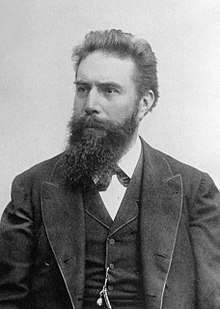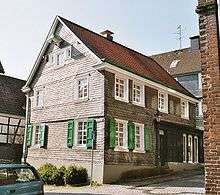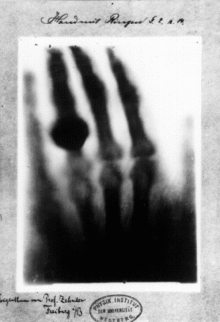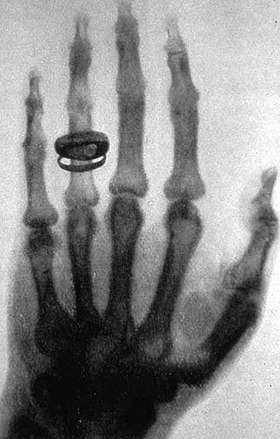Wilhelm Röntgen
| Wilhelm Röntgen | |
|---|---|
 | |
| Born |
Wilhelm Conrad Röntgen 27 March 1845 Lennep, Rhine Province, Kingdom of Prussia, German Confederation |
| Died |
10 February 1923 (aged 77) Munich, Bavaria, Germany |
| Nationality | German[1] |
| Alma mater | |
| Known for | Discovery of X-rays |
| Awards |
Matteucci Medal (1896) Rumford Medal (1896) Elliott Cresson Medal (1897) Barnard Medal (1900) Nobel Prize in Physics (1901) |
| Scientific career | |
| Fields |
Physics X-ray astronomy |
| Institutions | |
| Doctoral advisor | August Kundt |
| Doctoral students | |
| Other notable students | Franz S. Exner |
| Signature | |
|
| |
Wilhelm Conrad Röntgen (/ˈrɛntɡən,
Biography
Education
Born to a German father and a Dutch mother, Röntgen attended high school in Utrecht, Netherlands. In 1865, he was expelled from high school when one of his teachers intercepted a caricature. Without a high school diploma, Röntgen could only attend university in the Netherlands as a visitor. In 1865, he tried to attend Utrecht University without having the necessary credentials required for a regular student. Upon hearing that he could enter the Federal Polytechnic Institute in Zurich (today known as the ETH Zurich), he passed its examinations, and began studies there as a student of mechanical engineering. In 1869, he graduated with a Ph.D. from the University of Zurich; once there, he became a favorite student of Professor August Kundt, whom he followed to the University of Strassburg.[4]

Career
In 1874, Röntgen became a lecturer at the University of Strassburg. In 1875, he became a professor at the Academy of Agriculture at Hohenheim, Württemberg. He returned to Strassburg as a professor of physics in 1876, and in 1879, he was appointed to the chair of physics at the University of Giessen. In 1888, he obtained the physics chair at the University of Würzburg, and in 1900 at the University of Munich, by special request of the Bavarian government.
Röntgen had family in Iowa in the United States and planned to emigrate. He accepted an appointment at Columbia University in New York City and bought transatlantic tickets, before the outbreak of World War I changed his plans. He remained in Munich for the rest of his career.
During 1895, Röntgen was investigating the external effects from the various types of vacuum tube equipment — apparatuses from Heinrich Hertz, Johann Hittorf, William Crookes, Nikola Tesla and Philipp von Lenard — when an electrical discharge is passed through them.[5][6] In early November, he was repeating an experiment with one of Lenard's tubes in which a thin aluminium window had been added to permit the cathode rays to exit the tube but a cardboard covering was added to protect the aluminium from damage by the strong electrostatic field that produces the cathode rays. He knew the cardboard covering prevented light from escaping, yet Röntgen observed that the invisible cathode rays caused a fluorescent effect on a small cardboard screen painted with barium platinocyanide when it was placed close to the aluminium window. It occurred to Röntgen that the Crookes–Hittorf tube, which had a much thicker glass wall than the Lenard tube, might also cause this fluorescent effect.
In the late afternoon of 8 November 1895, Röntgen was determined to test his idea. He carefully constructed a black cardboard covering similar to the one he had used on the Lenard tube. He covered the Crookes–Hittorf tube with the cardboard and attached electrodes to a Ruhmkorff coil to generate an electrostatic charge. Before setting up the barium platinocyanide screen to test his idea, Röntgen darkened the room to test the opacity of his cardboard cover. As he passed the Ruhmkorff coil charge through the tube, he determined that the cover was light-tight and turned to prepare the next step of the experiment. It was at this point that Röntgen noticed a faint shimmering from a bench a few feet away from the tube. To be sure, he tried several more discharges and saw the same shimmering each time. Striking a match, he discovered the shimmering had come from the location of the barium platinocyanide screen he had been intending to use next.
Röntgen speculated that a new kind of ray might be responsible. 8 November was a Friday, so he took advantage of the weekend to repeat his experiments and made his first notes. In the following weeks he ate and slept in his laboratory as he investigated many properties of the new rays he temporarily termed "X-rays", using the mathematical designation ("X") for something unknown. The new rays came to bear his name in many languages as "Röntgen rays" (and the associated X-ray radiograms as "Röntgenograms").
At one point while he was investigating the ability of various materials to stop the rays, Röntgen brought a small piece of lead into position while a discharge was occurring. Röntgen thus saw the first radiographic image, his own flickering ghostly skeleton on the barium platinocyanide screen. He later reported that it was at this point that he determined to continue his experiments in secrecy, because he feared for his professional reputation if his observations were in error.
Nearly two weeks after his discovery, he took the very first picture using X-rays of his wife Anna Bertha's hand. When she saw her skeleton she exclaimed "I have seen my death!"[7] He later made a better picture of his friend Albert von Kölliker's hand at a public lecture.
Röntgen's original paper, "On A New Kind Of Rays" (Ueber eine neue Art von Strahlen), was published on 28 December 1895. On 5 January 1896, an Austrian newspaper reported Röntgen's discovery of a new type of radiation. Röntgen was awarded an honorary Doctor of Medicine degree from the University of Würzburg after his discovery. He published a total of three papers on X-rays between 1895 and 1897.[8] Today, Röntgen is considered the father of diagnostic radiology, the medical speciality which uses imaging to diagnose disease.
A collection of his papers is held at the National Library of Medicine in Bethesda, Maryland.[9]
Personal life

Röntgen was married to Anna Bertha Ludwig (m. 1872, d. 1919). They raised one child, Josephine Bertha Ludwig, whom they adopted at age 6 from Anna's brother in 1887.[10] Röntgen died on 10 February 1923 from carcinoma of the intestine.[11]


He inherited two Million Reichsmarks after his father's death.[12] With the inflation following World War I, Röntgen fell into bankruptcy later in life, spending his final years at his country home at Weilheim, near Munich.[5] In keeping with his will, all his personal and scientific correspondence was destroyed upon his death. [13]
Honours and awards
In 1901, Röntgen was awarded the first Nobel Prize in Physics. The award was officially "in recognition of the extraordinary services he has rendered by the discovery of the remarkable rays subsequently named after him". Röntgen donated the monetary reward from his Nobel Prize to his university. Like Pierre Curie, Röntgen refused to take out patents related to his discovery of X-rays, as he wanted society as a whole to benefit from practical applications of the phenomenon. Röntgen was also awarded Barnard Medal for Meritorious Service to Science in 1900.[14]
His honors include:
- Rumford Medal (1896)
- Matteucci Medal (1896)
- Elliott Cresson Medal (1897)
- Nobel Prize for Physics (1901)
- In November 2004 IUPAC named element number 111 roentgenium (Rg) in his honour. IUPAP adopted the name in November 2011.
In 1907 he became a foreign member of the Royal Netherlands Academy of Arts and Sciences.[15]
Legacy
Today, in Remscheid-Lennep, 40 kilometres east of Düsseldorf, the town in which Röntgen was born in 1845 is the Deutsches Röntgen-Museum.[16]
In Würzburg, where he discovered the X-rays, a non-profit organization maintains his laboratory and provides guided tours to the Röntgen Memorial Site.[17]
World Radiology Day: The International Day of Radiology is an annual event promoting the role of medical imaging in modern healthcare. It is celebrated on November 8 each year, coincides with the anniversary of the discovery of X-rays by Wilhelm Roentgen in 1895. It was first introduced in 2012, as a joint initiative, by the European Society of Radiology (ESR), the Radiological Society of North America (RSNA), and the American College of Radiology (ACR).
Röntgen Peak in Antarctica is named after Wilhelm Röntgen.[18]
See also
References
- 1 2 "Wilhelm Röntgen (1845-1923) – Ontdekker röntgenstraling". historiek.net.
- ↑ "Röntgen". Random House Webster's Unabridged Dictionary.
- ↑ Novelize, Robert. Squire's Fundamentals of Radiology. Harvard University Press. 5th edition. 1997. ISBN 0-674-83339-2 p. 1.
- ↑ Trevert, Edward (1988). Something About X-Rays for Everybody. Madison, WI: Medical Physics Publishing Corporation. p. 4. ISBN 0-944838-05-7.
- 1 2 Nitske, Robert W., The Life of W. C. Röntgen, Discoverer of the X-Ray, University of Arizona Press, 1971.
- ↑ Agar, Jon (2012). Science in the Twentieth Century and Beyond. Cambridge: Polity Press. p. 18. ISBN 978-0-7456-3469-2.
- ↑ Landwehr, Gottfried (1997). Hasse, A, ed. Röntgen centennial: X-rays in Natural and Life Sciences. Singapore: World Scientific. pp. 7–8. ISBN 981-02-3085-0.
- ↑ Wilhelm Röntgen, "Ueber eine neue Art von Strahlen. Vorläufige Mitteilung", in: Aus den Sitzungsberichten der Würzburger Physik.-medic. Gesellschaft Würzburg, pp. 137–147, 1895; Wilhelm Röntgen, "Eine neue Art von Strahlen. 2. Mitteilung", in: Aus den Sitzungsberichten der Würzburger Physik.-medic. Gesellschaft Würzburg, pp. 11–17, 1896; Wilhelm Röntgen, "Weitere Beobachtungen über die Eigenschaften der X-Strahlen", in: Mathematische und Naturwissenschaftliche Mitteilungen aus den Sitzungsberichten der Königlich Preußischen Akademie der Wissenschaften zu Berlin, pp. 392–406, 1897.
- ↑ "Fundamental contributions to the X-ray: the three original communications on a new kind of ray / Wilhelm Conrad Röentgen, 1972". National Library of Medicine.
- ↑ Glasser (1933: 63)
- ↑ Glasser, Otto (1933). Wilhelm Conrad Röntgen and the Early History of the Roentgen Rays. London: John Bale, Sons and Danielsson, Ltd. p. 305. OCLC 220696336.
- ↑ Hans-Erhard Lessing: Eminence thanks to fluorescence - Wilhelm Röntgen. German Life (Grantsville MD) Oct/Nov 1995 pp. 40-42
- ↑ https://upscgk.com/Online-gk/5852/wilhelm-conrad-r%C3%B6ntgen-was-born-on-march-27-1845
- ↑ "Award of Bernard Medal". Columbia Daily Spectator. XLIII (57). New York City. 23 May 1900. Retrieved 22 March 2018.
- ↑ "W.C. Röntgen (1845 - 1923)". Royal Netherlands Academy of Arts and Sciences. Retrieved 20 July 2015.
- ↑ Deutsches Röntgen-Museum at roentgen-museum.de
- ↑ Röntgen Memorial Site at wilhelmconradroentgen.de
- ↑ Röntgen Peak. SCAR Composite Antarctic Gazetteer
External links
| Wikimedia Commons has media related to Wilhelm Conrad Röntgen. |
| Wikiquote has quotations related to: Wilhelm Röntgen |
| Wikisource has original works written by or about: Wilhelm Röntgen |
- Biography at the official Nobel site
- Annotated bibliography for Wilhelm Röntgen from the Alsos Digital Library
- Wilhelm Conrad Röntgen Biography
- The Cathode Ray Tube site
- First X-ray Photogram
- The American Roentgen Ray Society
- Deutsches Röntgen-Museum (German Röntgen Museum, Remscheid-Lennep)
- Works by or about Wilhelm Röntgen at Internet Archive
- Works by Wilhelm Röntgen at LibriVox (public domain audiobooks)

- Works by Wilhelm Röntgen at LibriVox (public domain audiobooks)

- WC Roentgen – Medcyclopedia
- Röntgen Rays: Memoirs by Röntgen, Stokes, and J.J. Thomson (circa 1899)
- Some places and memories related to Wilhelm Conrad Roentgen on Himetop – The History of Medicine Topographical Database
- The New Marvel in Photography, an article on and interview with Röntgen, in McClure's magazine, Vol. 6, No. 5, April, 1896, from Project Gutenberg
- Wilhelm Röntgen at Find a Grave
- Röntgen's 1895 article, on line and analyzed on BibNum [click 'à télécharger' for English analysis]
- Open Library
- Newspaper clippings about Wilhelm Röntgen in the 20th Century Press Archives of the German National Library of Economics (ZBW)
